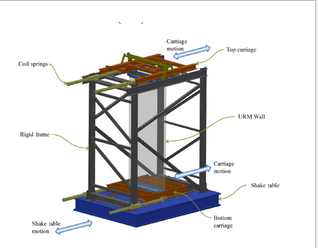1 PhD Candidate, Department of Civil Engineering, University of British Columbia, Vancouver, BC, V6T 1Z4, Canada, openner@gmail.com
2 Associate Professor, Department of Civil Engineering, University of British Columbia, Vancouver, BC, V6T 1Z4, Canada, elwood@civil.ubc.ca
ABSTRACT
The vulnerability of unreinforced masonry (URM) buildings to out-of-plane damage and collapse has been clearly demonstrated in past earthquakes, most recently in the 2010 and 2011 earthquakes near Christchurch, New Zealand. A cost-effective, widely-used approach for reducing the out-of-plane vulnerability of URM walls is to connect the walls to the diaphragms. Given sufficient anchorage to the diaphragms, a URM wall subjected to out-of-plane inertial forces will likely develop a horizontal crack above mid-height. This crack will cause the wall to behave as two semi-rigid bodies, which rock in the out-of-plane direction. Past studies have demonstrated that the out-of-plane stability of a URM wall connected to the diaphragms can be related to the height to thickness ratio and the spectral acceleration at 1.0 second. However, treatment of the effect of diaphragm flexibility on out-of-plane wall stability in studies to date has been limited.
This paper describes an experimental study examining the out-of-plane stability under seismic loading of URM walls connected to flexible diaphragms. Five full-scale unreinforced solid clay brick wall specimens spanning one storey were subjected to earthquake ground motions on a shake table. The top and bottom of the walls were connected to the shake table through coil springs, simulating the flexibility of the diaphragms. The apparatus allowed the wall supports to undergo large absolute displacements, as well as out-of-phase top and bottom displacements, consistent with the expected performance of URM buildings with unretrofitted timber diaphragms. Variables examined included diaphragm stiffness and wall height. Experimental results are compared with output from an analytical rigid-body rocking model.
KEYWORDS: unreinforced masonry, wall, shake table, out-of-plane, diaphragm, stability, earthquakes, seismic retrofit
325.pdf



